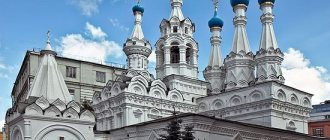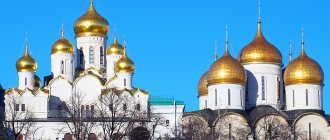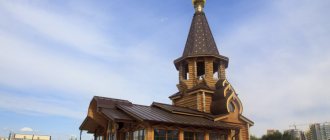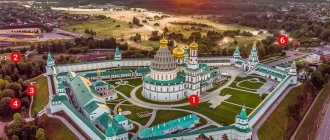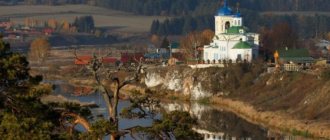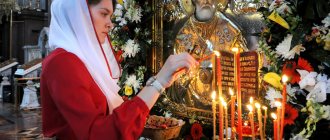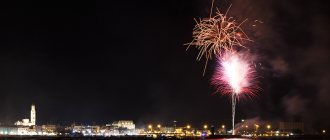Category: Monasteries, temples and churches
The Moscow region is famous for its monasteries and churches. According to the latest data, in the Moscow region there are now more than 1 thousand places of worship that were built before 1980. Among them, 10 churches date back to the 14th-15th centuries and are of undoubted historical value.
Among the churches of the Moscow region there are many interesting and original religious buildings that attract tourists from different parts of Russia.
Church of St. Nicholas the Wonderworker, p. Kamenskoye
This village in the Naro-Fominsk district of the Moscow region can be proud of having one of the most ancient churches in the Moscow region. Its construction dates back to the 14th century. It is single-domed, built of roughly hewn white stone in a “pylon style” without pillars. This is a rare example of Slavic architecture. The external and internal decoration of the church is poorly decorated. Since 1999, services have been held there, there is a Sunday school, and a library.
Church of the Conception of John the Baptist, p. Gorodishche, Kolomna
One of the most beautiful buildings of the late 14th century in the Moscow region. It belongs to the same architectural style as the Church of St. Nicholas in Kamenskoye. The lower floor is built of rough-hewn limestone. The upper part of the temple was rebuilt in the 16th century and is made of brick and smooth stone. The external and internal decoration is characteristic of that time, devoid of pretentiousness and pomp. When you get to the temple, you are distracted from everything earthly, remaining alone with God.
To the left of the entrance on the wall there is a bas-relief depicting a mythical beast similar to a wolf or basilisk. He is also depicted on the coat of arms of the city of Kolomna.
This ancient temple is alive. Divine services are held there and there is a Sunday school.
Holy Trinity Cathedral of the Sergius Trinity Lavra, Sergiev Posad
Refers to buildings from the early 15th century. It was erected in honor of the late wonderworker Sergius of Radonezh , whose relics were found during construction. Now they rest in the temple in a silver shrine and are the object of worship of believers. This is the main temple of the Trinity-Sergius Lavra, within the walls of which monks still take monastic vows.
The interior walls and iconostasis of the cathedral were painted by the famous Andrei Rublev and Daniil Cherny. Their frescoes have been preserved to this day only thanks to restoration work, which exactly replicates the original paintings.
The temple was often visited by representatives of the royal family: Ivan the Terrible, Princess Sophia, Peter the Great.
Excursions are held on the territory of the Lavra, the Moscow Theological Seminary, a historical museum, workshops, and a publishing house operate. This is a museum-reserve. Protected by UNESCO.
Church of the Transfiguration, p. Island
Erected during the reign of Ivan IV the Terrible. This is a tent-shaped scar, built of white limestone, decorated with semi-circular “fire” kokoshniks. Its base is a cross on which an octagonal tent is placed. The entrance is through the bell tower built in the 19th century, made in pseudo-Gothic style. The ancient interior decoration has not been preserved. The temple is operational.
Church of the Nativity of the Virgin Mary in Podmoklovo
Located in the village of Podmoklovo, Moscow region. The wooden church was built at the beginning of the 17th century . By order of Prince Grigory Dolgorukov, the owner of the village, in 1714, on the site of the old one, the construction of a stone church began, which was made in the style of the Italian Renaissance with Baroque elements. Now this building is an octagonal rotunda with a gallery and statues of 4 evangelists and 12 apostles.
In the church there is an ancient icon of the Mother of God of Vladimir, icons of Italian masters of painting. The paintings on the walls and the painting of the Last Judgment are impressive. For a long time there was a scandal around her because of the portrait resemblance of one of the martyrs to M.Yu. Lermontov. At the beginning of the twentieth century, at the request of literary aesthetes, the face of the martyr was changed.
Of particular value is the stone carving made by carvers from the master Zimin’s artel.
The church holds services and has a library. It has already become a tradition to hold a classical music festival on its territory at the end of June.
Temples of the Moscow region. Assumption Cathedral of the Kashirch Kremlin
The monumental structure was built in the former Kashira Kremlin in the middle of the 19th century. The original building was destroyed by fire back in 1718, and for a long time there were ruins on the site, since all the craftsmen were recalled to the construction of the capital. At the beginning of the 19th century, construction of a new cathedral began. The construction was carried out with funds from local philanthropists. The Empire style was chosen for the temple. The hitherto unknown architect chose impressive building elements. The single mass of the structure is completed by a majestic five-domed structure with a light domed rotunda, which contrasts with small closed side drums. The side facades of the temple are equipped with six-column Tuscan porticoes. The walls are decorated with heavy Doric cornices and light rustication. The ensemble is complemented by a massive three-tier bell tower.
Church of the Vladimir Icon of the Mother of God, p. Bykovo
The initiator of the construction was the senator and owner of the estate in the village of Bykovo Mikhail Izmailov . Erected in 1789 according to the design of V.I. Bazhenova. Some historians attribute the authorship to M.F. Kozakov.
In appearance it resembles an old medieval castle. The architecture successfully combines Gothic and Baroque. Richly decorated. There is no worthy analogue of such a church in Russian architecture.
The first floor of the temple is a functioning church. Restoration work is underway on the upper floors.
Inside is the miraculous icon of the Mother of God of Vladimir. Also an icon of St. Nicholas the Wonderworker, donated by Tsar Nicholas I.
St. Nicholas Church (Kamenskoye village)
Thus, the oldest stone church in the Moscow region is considered to be the St. Nicholas Church, which is located in the village of Kamenskoye and was built, according to historians, in the second half of the 14th century. True, scientists to this day cannot understand why one of the very first stone churches in Muscovy was built in this distant village.
As for the St. Nicholas Church itself, its architectural image is very laconic. He is both strict and graceful. This is a single-domed, three-apse temple, entirely made of white stone processed using a “semi-clean” technique. It was built according to the “pylon type,” which is quite rare in Russian architecture.
Church of the Sign of the Blessed Virgin Mary in Dubrovitsy
Located in the village of Dubrovitsy, Moscow region. The stone temple was built on the site of a wooden church at the expense of Prince Boris Golitsyn in 1967. The head of the Russian Orthodox Church, Patriarch Adrian, did not consent to its consecration, because... the construction was made in the spirit of Orthodox traditions, but with elements of Catholic architecture and iconography. On its walls there are high reliefs depicting scenes from the Bible and poems in Latin. In 1704, the temple was consecrated. Peter himself was present at its consecration with Tsarevich Alexei . During the October Revolution, the church was ruined. Worship services resumed only in 1990.
The temple is operational and is classified as an architectural monument protected by UNESCO. There is a Sunday school. The revered icon is the Mother of God “The Sign”, which is already more than 150 years old.
6) Temple of the Grebnevo Icon of the Mother of God in the Grebnevo estate
The Grebnevskaya Church (the summer church of the village of Grebneva) is well known in our Moscow region, first of all, as an outstanding architectural monument of the 18th century. The architect of the temple is Ivan Vetrov (John Vetter). Anyone who sees the church for the first time is impressed by the gilded angel on the drum of the dome, effectively crowning the entire structure. The traditions of Orthodox architecture required the creation of a temple according to the formula of an octagon on a quadrangle: four walls of the temple and an octagonal drum of a load-bearing dome. Ivan Vetrov covered the four walls of the temple behind the porticoes, replaced the octagon with a round drum with twelve round niches with portraits of Christ’s disciples and interlocutors. In 1984, the painting was updated and the bright portraits of the evangelists and apostles “sounded”, as the Russian architect intended. In the summer Grebnevsky Church there are two especially revered icons: St. Nicholas of Mozhaisk in a silver-plated copper robe and the Smolensk Icon of the Mother of God.
Temple of the Archangel Michael in Balashikha
Its construction is associated with the name of the great-grandson of Yuri Dolgoruky, Prince Alexander , who began the construction of a stone church on the site of a wooden one in 1748. In 1789, construction was completed.
Built of plastered brick and white stone in the Moscow Baroque style. It has two thrones: the upper one is in honor of Michael the Archangel, the lower one is in honor of St. Nicholas the Wonderworker. The inside is decorated with rich stucco patterns. The gilded iconostasis consists of icons from the 18th century. During the service, ancient church utensils are used.
LiveInternetLiveInternet
The pearl of the entire Bykovo estate, undoubtedly, was a two-story church, built, presumably, according to the design of V.I. Bazhenov in 1789 in honor of the Vladimir Mother of God on the site where the wooden Church of the Nativity of Christ had been located since ancient times. Experts say that this is our only oval-shaped temple. On its lower floor there was the Church of the Nativity of Christ, and on the second floor there was the Church of the Vladimir Mother of God. Most of the architectural techniques of the Vladimir Church have no analogues in Russian church architecture: these are paired bell towers with spiers on the sides of the church facade, and a curved staircase leading to the upper church (the church is two-story, the upper church has preserved decoration in the style of classicism), and the apse, decorated with a “forest of spiers”. The Vladimir Church can be considered one of the most beautiful churches in Russia. A bell tower, similar in style to the church itself, was erected next to the church in 1883 (presumably by the architect Ivan Trofimovich Tamansky). The church was conceived and built as a memory of the deceased wife of Prince Izmailov, Maria Alexandrovna. This is evidenced by the unique bas-reliefs placed around the perimeter of the church, which in an allegorical form tell about the life of the spouses.
6) Temple of the Grebnevo Icon of the Mother of God in the Grebnevo estate
The Grebnevskaya Church (the summer church of the village of Grebneva) is well known in our Moscow region, first of all, as an outstanding architectural monument of the 18th century. The architect of the temple is Ivan Vetrov (John Vetter). Anyone who sees the church for the first time is impressed by the gilded angel on the drum of the dome, effectively crowning the entire structure. The traditions of Orthodox architecture required the creation of a temple according to the formula of an octagon on a quadrangle: four walls of the temple and an octagonal drum of a load-bearing dome. Ivan Vetrov covered the four walls of the temple behind the porticoes, replaced the octagon with a round drum with twelve round niches with portraits of Christ’s disciples and interlocutors. In 1984, the painting was updated and the bright portraits of the evangelists and apostles “sounded”, as the Russian architect intended. In the summer Grebnevsky Church there are two especially revered icons: St. Nicholas of Mozhaisk in a silver-plated copper robe and the Smolensk Icon of the Mother of God.
7) St. Nicholas Church in the Tsarevo estate
The authorship of the St. Nicholas Church in the village of Tsarevo is attributed to the architect I.V. Egotov, who was a student of the famous architects V.I. Bazhenov and M.F. Kazakova. The church in Gothic forms was erected in 1812-1815, when the owners of the village were representatives of the Durasov family. Egotov also created the Lyublino estate for N.A. Durasov, worked in Kuzminki and designed the Milovida, Nerastankino pavilions and the Temple of Ceres gazebo in Tsaritsyno. The facades of the building, dissected by highly elongated trunks of stone three-quarter columns, are surrounded by a bas-relief frieze of a beautiful design by the sculptor Gavriil Tikhonovich Zamaraev.
 Intercession and Vasilyevskaya churches in the Chirkino estate
Intercession and Vasilyevskaya churches in the Chirkino estate
At the end of the 17th century, the Church of the Intercession was rebuilt by boyar Vasily Sheremetev. The pillarless three-apse temple acquired the composition “octagon on quadrangle”. He also had decorative decoration of the second octagonal tier in the Moscow Baroque style. V.B. Sheremetev also built the Vasilyevskaya Church, surrounded by an open gallery-promenade. The temple, built in the Moscow Baroque style, was used as a family tomb. The tiered pillar-shaped Vasilievsky Church “under the ringing” is made of brick. It is a unique version of patrimonial bell-tower churches from the heyday of the Moscow Baroque.
9) Spassky Church in the Ubory estate
The Spasskaya Church in Ubory was built in 169-1697 according to the design of the outstanding architect Yakov Bukhvostov. This incredibly beautiful temple is one of the rarest examples of Naryshkin baroque. The impeccable proportions of the church are complemented by luxurious decorative furnishings. Glyptography (glyptics, stone carving) reaching lace openwork in the second tier is not at all applicative or static, it is of an unusually voluminous, rich and temperamental nature. The carved white stone here is so plastic that at first it appears as stucco, sculpturally protruding on the smooth terracotta surface of the walls.
1) Transfiguration Church and belfry in the Bolshiye Vyazemy estate
The Church of the Transfiguration is a four-pillar, five-domed church of the cross-domed type with two symmetrical aisles, placed on a basement and surrounded on three sides by open galleries. The pillars and walls of the temple up to the zakomara level are made of white stone, the crowning parts of the building and galleries are made of brick. Next to the temple on the north side there is a belfry in the form of a three-span wall, placed on an open terrace - a walkway. In its architectural design, the belfry is close to the decoration of the church. It is made of brick, with white stone details. This temple was probably built from 1584 to 16.
11) Spasskaya Church in the Voronovo estate
The Spasskaya Church was built in the second half of the 18th century. A prominent representative of Baroque architecture, it is stylistically attributed to the work of C. Blanc. During Soviet times, the temple was not closed, thanks to which the original interior has been preserved to this day. The Church of the Savior is a type of temple “octagonal on quadrangular”, interpreted in a new way in accordance with compositional techniques that characterize the formation of the style of Russian classicism. The crepe facades, processed in order forms, are rich in architectural plasticity. Developed cornices, richly patterned frames, cartouches and stucco moldings above the windows give them an almost sculptural expressiveness. In the bell tower, apparently also built by Blank, but somewhat later than the church, the traditional tiered structure characteristic of Russian tower compositions of the pre-Petrine era is preserved. The bell tower has a unique design of the order structure, richness of decor, the introduction of large arched openings, thanks to which the building is permeated with light and air and seems unusually light, as if merging with the surrounding nature.
12) Vvedenskaya Church in the Vvedenskoye estate
The Vvedenskaya Church was built according to the design of N.A. Lvov in 1812, after the death of the architect himself. The combination of the spire, characteristic of Western temple architecture, and the classical style makes the temple amazingly beautiful.
13) Kazan Church in the Yaropolets Chernyshevs’ estate
The Kazan temple, built on the Chernyshev estate, is mistakenly called a theater by some, while others classify it as a Masonic monument. In fact, there is no Masonic symbolism in the architecture and decoration of the church, and theatrical performances have never been held here. Idea by Z.G. Chernyshev’s idea of combining the estate church and tomb into one whole gave rise to a composition unique to Russian architecture. The first temple on the Chernyshevskaya half of Yaropolets appeared in 1742. In documents from 1782, “in the village of Eropolch Kazanskoe, the same stone church in the name of the Kazan Most Holy Theotokos is now being built, half rebuilt.” A number of later documents indicate the date of the illumination of the temple as 1798. Perhaps Countess Chernysheva turned to the architect Bazhenov for a design for the interior design of the temple. Bazhenov provided the widow with his drawings, composed a decoration program and recommended artists and sculptors from his team. The interiors of the temple and tomb are made at a higher artistic level than the external architecture. The temple is designed in the form of a spacious rectangular hall, closed in the depths by a semicircle of the altar. The temple has miraculously survived to this day and is in need of restoration.
14) Church of the Savior Not Made by Hands in the Abramtsevo estate
Church of the Savior Not Made by Hands in Abramtsevo, built according to the design of V.M. Vasnetsov and V.D. Polenov in 1881-1882. The temple in Abramtsevo became the Mamontov family tomb, their last “earthly refuge.” In 197, the grave of the Mamontovs’ daughter Vera (in marriage – Samarina) appeared near the walls of the church - the same “girl with peaches” that Serov once depicted in his famous painting. The builders of the temple managed to create an unusually expressive architectural image, in which the features of different schools of Russian church architecture can be read. The very appearance of the temple is reminiscent of Novgorod churches in its impressiveness; the belfry above the entrance is characteristic of Pskov architecture, and the ceramic inserts are reminiscent of Yaroslavl churches.
15) Church of St. Nicholas the Wonderworker in the Petrovskoye estate
The stone tented church of St. Nicholas the Wonderworker is the oldest building of the Petrovskoye estate. It was staged back in 1685 under I.M. Miloslavsky. At this time, the owners of Petrovsky were the Miloslavsky boyars. Around the same time, another tented temple was built in the Annino estate, another estate of the Miloslavskys. Patriarch Nikon at this time had already issued a ban on the construction of tented churches. Therefore, such a gesture on the part of the Miloslavsky boyars, who were opponents of the reform, was clearly oppositional. The temple was erected on the site of an old dilapidated wooden church.
St. Nicholas Cathedral in Mozhaisk
Located in the city of Mozhaisk, Moscow region on the territory of the ancient Mozhaisk fortress. The cathedral was built from 1802 to 1814. designed by architect Alexey Bakarev . This is a two-story building in the Russian Gothic style, combining elements of European and Russian architecture. The first floor of the temple is made of natural stone. In the 14th century, this place was the location of the St. Nicholas Gate and the gate church, which housed the miraculous carved icon of St. Nicholas of Mozhaisk. The image was given to the Tretyakov Gallery, and there is an exact copy of it in the cathedral. From 1933 to 1993, no services were held in the cathedral. Nowadays the temple is operational. There is a children's choir and a daily soup kitchen.
Assumption Cathedral on Gorodok (Zvenigorod)
Scientists include the Assumption Cathedral on Gorodok, in Zvenigorod, among the best monuments of early Moscow architecture at the turn of the 14th-15th centuries. This famous temple in the Moscow region was built in 1399-1401 at the behest of Prince Yuri Dmitrievich (Zvenigorodsky) and for a long time remained the only stone structure of the Zvenigorod Kremlin.
The appearance of this single-domed, four-pillar ancient cathedral is similar to pre-Mongol temples, but has special features of the so-called “Moscow style” of the 15th century, which gives it an aristocratic appearance. The greatest value is represented by the frescoes preserved in the cathedral by the masters of the “Rublev school”. Some experts believe that these are the works of Rublev himself, as well as Daniil Cherny. Among them is the famous Zvenigorod Deesis, which depicts the Savior, Apostle Paul and Archangel Michael. True, today all these icons are in the Tretyakov Gallery.
